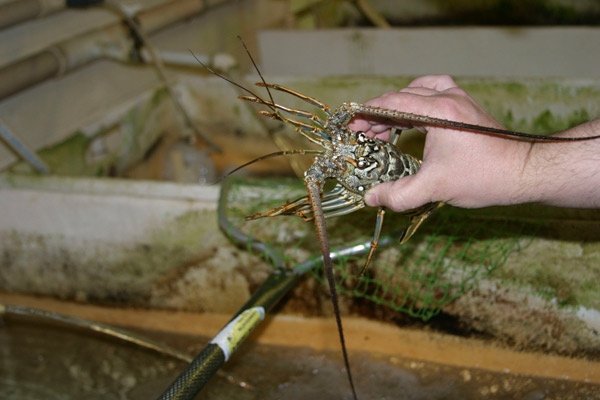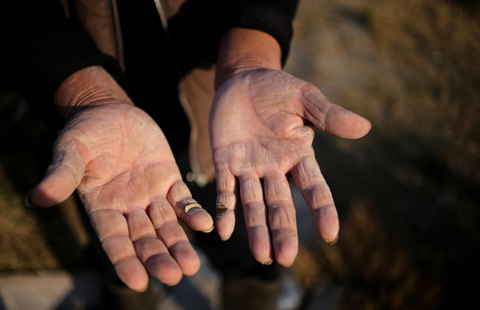Florida lobsters find a market in China
Updated: 2014-12-25 06:42
By PAUL WELITZKIN in New York(China Daily USA)
|
||||||||
 |
| Researcher Yuriy V. Bobkov of the UF Whitney Laboratory for Marine Bioscience holds a Florida spiny lobster in the laboratory in San Augustine, Florida, in this undated handout photo obtained by Reuters on March 17, 2014. REUTERS/Chris Bilowich |
The US lobster trade with China is growing rapidly, especially for a species called the spiny lobster that is harvested in the Florida Keys.
"China has upended the supply chain for lobster," John Sackton, publisher of SeafoodNews.com in Lexington, Massachusetts, told China Daily in an interview on Monday. "The Chinese prefer the spiny lobster over its better known brethren the North American or Maine lobster. Part of the reason is cultural – the Chinese think of a spiny lobster as similar to a dragon prawn and the dragon is a very powerful symbol in China."
One difference between the spiny lobster and the North American version is the time each species takes to mature.
"The Caribbean spiny lobster (the species caught in Florida) matures in its second year after the larvae settle. The American lobster, also known as the Maine lobster, has a much more variable age at maturity, often over 5 years. The longer time to maturity is mostly related to the water temperature. The cold-water American lobster matures much more slowly. The average lobster in Florida is harvested at about 18 months old and it weighs about 1 pound," Tom Matthews, an associate research scientist with the Florida Fish and Wildlife Conservation Commission (FWC) said in an e-mail.
Sackton said Australia used to be the prime supplier of spiny lobster to China. "When the Australians had trouble filling the orders, the Chinese turned to the US, specifically in the Florida Keys," he said.
In 2013, the US exported about $7.3 million of spiny lobster to China, up from about $3.2 million the previous year, according to a report in Miami Today and data from the National Oceanic and Atmospheric Administration.
"The Caribbean spiny lobster is found from Brazil to Bermuda. The major countries that catch this lobster are Brazil, Cuba, the Bahamas, Nicaragua and Honduras. In Florida the commercial fishery is only in south Florida, mostly the Florida Keys. Recreational fishermen catch small numbers of lobsters in all the waters surrounding the state," said Matthews.
He said the Caribbean spiny lobster is a carnivore. It eats any small snail or other crustacean that it can catch and fit into its mouth. Although they will scavenge, there are generally not many dead animals in a healthy ecosystem, so lobsters are not naturally scavengers. In the Caribbean lobsters reproduce in all months. In Florida, because of our semi-tropical climate, lobsters reproduce mostly from April to July.
Sackton said the Chinese made it clear that they prefer a live lobster. "They want a live lobster flown to China and they are willing to pay for it. They got the fleet in the Florida Keys to change some of their tactics to meet this requirement," he added.
Because China is such a huge market, Sackton said regulatory agencies must adopt safeguards to ensure the spiny lobster population thrives.
The FWC must conduct enforcement against poaching," he said. "They also need to look out for traps that are set in protected areas or national parks."
The wholesale price of a lobster tail in the US, which is similar to a spiny lobster, is about $20 pound, Sackton said. In China, the Australian live spiny lobster costs about $80 to $100 a jinn, the Chinese measure equivalent to a US pound, and the cost of a North American lobster in China is $20 a jiin, he said.
paulwelitzkin@chinadailyusa.com
- 'Miss Leisure World' candidates play war game
- Metro use drops slightly as new fare hikes kick in
- Record passenger numbers expected for upcoming chunyun
- Children step out of Daliang Mountain
- 1,000 years on, the art of fish hunting is in safe hands
- National Stadium illuminated to greet New Year countdown

 Top 10 happiest cities in China 2014
Top 10 happiest cities in China 2014
 Children step out of Daliang Mountain
Children step out of Daliang Mountain
 New Consul General of China in New York arrives at JFK
New Consul General of China in New York arrives at JFK
 Missing AirAsia plane maybe at sea bottom
Missing AirAsia plane maybe at sea bottom
 Chinese artists get Times Square spotlight
Chinese artists get Times Square spotlight
 Yearender: Best selling Chinese films in 2014
Yearender: Best selling Chinese films in 2014
 Top 10 policy changes of China in 2014
Top 10 policy changes of China in 2014
 Families of MH370's passengers still hold out hope
Families of MH370's passengers still hold out hope
Most Viewed
Editor's Picks

|

|

|

|

|

|
Today's Top News
Xiaomi's sky-high value also comes with potential obstacles
Bright lights for Chinese artists
Expiration dates on food probed
'New normal' focus for new consul general in NY
Bodies, debris from missing plane pulled from sea
Chinatown rallies to aid slain officer's family
Chinese FM: Against any cyber attack
China says no role in Sony hacking
US Weekly

|

|







